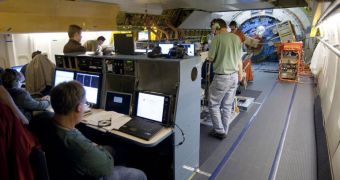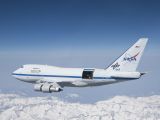NASA officials announce that the world's only airborne infrared observatory is currently being prepared for a new mission, which will last intermittently from November 2011 to December 2012.
The asset, which represents the result of a strong collaborative effort between the American space agency and the German Aerospace Center (DLR), is called the Stratospheric Observatory for Infrared Astronomy (SOFIA).
According to the joint team, this will be the aircraft's first full cycle of science flights. Yesterday, Erick Young – who is the observatory's Science Mission Operations director – announced the list of research team that was awarded time on SOFIA.
This unique infrared observatory provides astronomers with the ability to study the night sky at locations where cloud covers prevent ground-based observations. The only solution to bypass this problem until now has been to put infrared detectors in space, but that is expensive.
A heavily-modified Boeing 74SP aircraft, SOFIA can fly over the cloud cover, at altitudes of around 12 kilometers (39,000 feet), carrying a massive, 2.5-meter (100-inch) telescope. Special equipment ensures that the instrument is always pointed in the right direction.
“More than 1,000 hours of observing time were requested, five times the amount available, evidence of SOFIA’s desirability to astronomers,” Young announced yesterday in a statement.
“The approved projects make good use of the observatory’s capabilities to study objects ranging from Earth’s solar system neighbors to galaxies hundreds of millions of light years away,” he continued.
During the “Early Science” test program, which lasted throughout 2011, SOFIA conducted around 30 flights, and flew from its home, the NASA Dryden Flight Research Center's Aircraft Operations Facility, in Palmdale, California, to a DLR installation, in Germany.
During the upcoming, Cycle 1 flights, SOFIA will use four of its science instruments, the FORCAST mid-infrared camera and spectrometer, the GREAT far-infrared spectrometer, the HIPO high-speed photometer, and the FLITECAM near-infrared camera and spectrometer.
“The newly announced observing period, known as Cycle 1, includes 46 science flights grouped in four multi-week observing campaigns spread through a 13-month span,” NASA officials conclude.

 14 DAY TRIAL //
14 DAY TRIAL // 
